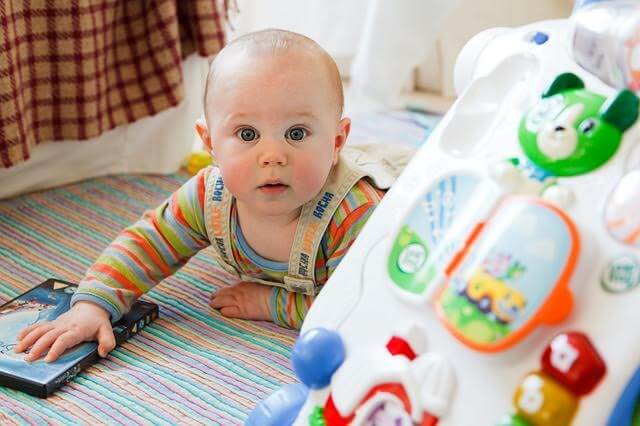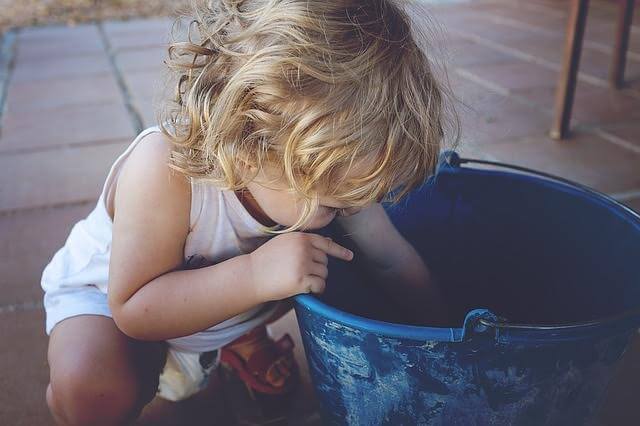Why Do Babies Throw Everything On The Floor?


Reviewed and approved by the psychologist María Alejandra Castro Arbeláez
Babies go through a phase in which their best ability is to throw everything on the floor. Do you want to know why they do this?
Surely, your child has surprised you on several occasions with their baseball player type skills, throwing everything they have within reach to the ground.
Perhaps, at first you believed this to be an act of rebellion or an action they use to get your attention. This perception, however, changes when you realize that they do this every day.
Either with anger, surprise or laughter, you will ask them to stop throwing things because they can damage something or hurt someone. We have some good news for you; this skill is just one of the first ways that children get to interact with the world.
Your baby is discovering the world every time they throw something on the ground
When you throw an object, you need to measure with which force you will launch it, have a fixed objective and also put yourself in a specific position. This is the experience that your little child is trying to earn every time they throw something to the ground.
If they have already thrown an object a thousand times, you must prepare yourself because they will surely do it a thousand times more.
Be happy and grateful because this is a sign of evolution and growth, it adds to the list of abilities your child develops in order to face the challenges of life.
Guide them, teach them to be careful, how to identify danger and how to recognize sensitive materials.
Throw everything on the floor: a source of learning

We see how children’s bodies start to get stronger and more agile simply by throwing everything on the floor. It is time to guide them through this task.
At a young age this is an odyssey full of challenges and achievements just like those of a superhero.
In this sense, before getting involved with this task, it is essential that we know in detail what your little angel learns by throwing things on the floor.
Discovering what happens with the object
They watch to see if it breaks, makes special sounds or stays the same. They answer their doubts with practice, for example; they will throw objects they are curious about as many times as necessary until they confirm their answer.
Measuring distances
Even though you don’t believe it, children at this age use two of the greatest senses: sight and hearing. They visually analyze the trajectory of the object that they throw.
They see how the object varies in size as it moves away until it becomes tiny. They also use hearing to see how long it takes to hit the ground. A late sound means the object travelled further.
Testing their skills
Is it worthwhile to continue experimenting with this object? Should I keep exploring? Did I understand what happens when I throw it with force? Will it react differently If I do?
They already understand the relationship between cause and effect.
After they decide to throw an object, they then discover what this causes. It could cause glass to break and a reaction of fear from mom or dad. It could also cause a loud noise that bothers other and wakes up their parents, etc.
Social interaction
They will notice that certain sounds and actions awaken the interest of those around them. They will then play with these objects in order to create magical moments to share with you.
This is another opportunity they have to create connections. In the future the lessons they learn as children will be transcendental in their personal and professional development.
Our little scientist responds to thier needs for exploration with speed and cunning.
What can we do to improve this experience?

You should not scold them unless they throw something delicate or cause a lot of damage. Instead, you can focus on teaching them what they can throw and where they can throw it.
You should not allow them to be aggressive in these sessions. You can also invite them to pick up the things they threw with you in order to create a habit of being organized.
Do not scold them unnecessarily, lead by example and you will see the results
Teach by example about what is allowed. For example, throwing dirty socks into the basket or useless papers into the trash. Little by little they will understand what is right and this will be beneficial to both of you.
Babies go through a phase in which their best ability is to throw everything on the floor. Do you want to know why they do this?
Surely, your child has surprised you on several occasions with their baseball player type skills, throwing everything they have within reach to the ground.
Perhaps, at first you believed this to be an act of rebellion or an action they use to get your attention. This perception, however, changes when you realize that they do this every day.
Either with anger, surprise or laughter, you will ask them to stop throwing things because they can damage something or hurt someone. We have some good news for you; this skill is just one of the first ways that children get to interact with the world.
Your baby is discovering the world every time they throw something on the ground
When you throw an object, you need to measure with which force you will launch it, have a fixed objective and also put yourself in a specific position. This is the experience that your little child is trying to earn every time they throw something to the ground.
If they have already thrown an object a thousand times, you must prepare yourself because they will surely do it a thousand times more.
Be happy and grateful because this is a sign of evolution and growth, it adds to the list of abilities your child develops in order to face the challenges of life.
Guide them, teach them to be careful, how to identify danger and how to recognize sensitive materials.
Throw everything on the floor: a source of learning

We see how children’s bodies start to get stronger and more agile simply by throwing everything on the floor. It is time to guide them through this task.
At a young age this is an odyssey full of challenges and achievements just like those of a superhero.
In this sense, before getting involved with this task, it is essential that we know in detail what your little angel learns by throwing things on the floor.
Discovering what happens with the object
They watch to see if it breaks, makes special sounds or stays the same. They answer their doubts with practice, for example; they will throw objects they are curious about as many times as necessary until they confirm their answer.
Measuring distances
Even though you don’t believe it, children at this age use two of the greatest senses: sight and hearing. They visually analyze the trajectory of the object that they throw.
They see how the object varies in size as it moves away until it becomes tiny. They also use hearing to see how long it takes to hit the ground. A late sound means the object travelled further.
Testing their skills
Is it worthwhile to continue experimenting with this object? Should I keep exploring? Did I understand what happens when I throw it with force? Will it react differently If I do?
They already understand the relationship between cause and effect.
After they decide to throw an object, they then discover what this causes. It could cause glass to break and a reaction of fear from mom or dad. It could also cause a loud noise that bothers other and wakes up their parents, etc.
Social interaction
They will notice that certain sounds and actions awaken the interest of those around them. They will then play with these objects in order to create magical moments to share with you.
This is another opportunity they have to create connections. In the future the lessons they learn as children will be transcendental in their personal and professional development.
Our little scientist responds to thier needs for exploration with speed and cunning.
What can we do to improve this experience?

You should not scold them unless they throw something delicate or cause a lot of damage. Instead, you can focus on teaching them what they can throw and where they can throw it.
You should not allow them to be aggressive in these sessions. You can also invite them to pick up the things they threw with you in order to create a habit of being organized.
Do not scold them unnecessarily, lead by example and you will see the results
Teach by example about what is allowed. For example, throwing dirty socks into the basket or useless papers into the trash. Little by little they will understand what is right and this will be beneficial to both of you.
This text is provided for informational purposes only and does not replace consultation with a professional. If in doubt, consult your specialist.








